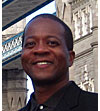
Start your presentations the way that they should end – with your audience wanting more.
Charles Greene give us some pointers.
Your start should be strong, confident, and engaging. It should provide the audience with absolute assurance that you are worth their time. All attention is focused on you, so it’s critical that you open strong as it sets the bar for your presentation that follows.
From your opening your audience will decide whether to stay with you or tune out. Linford Christie, Olympic Gold medallist sprinter, said that he started his races not merely at the ‘bang’ of the starting pistol, but at ‘The B of the Bang’. Start weak and today’s mobile-savvy audiences will start texting before the ‘G’ of the Bang.
Let’s look at the bigger picture of an opening before we delve into specific options. Your start needs to reveal the direction of your presentation and your concern for the audience, not you, your company or your agenda. Heading off in the direction of “me and my company” will make your audience rush to tweet and text, but not about you. A good start pulls the audience towards you.
You get one chance to make a first impression. Make sure your opening actually works by rehearsing and testing it. Rehearse your opening until you can do it like you breathe, without thinking. If you have an opening that is technology dependent, test and re-test the technology at the presentation site. Don’t let technology gremlins sabotage your presentation at the start.
A strong opening should focus on your audience and not you. No matter how well you open your presentation, you’ll miss the desired outcome if the emphasis is not placed on engaging the audience or addressing their issues.
Not all openings, even the great ones, are appropriate for all presentations. So, read the following openers, consider their application to your presentation, and then choose the best one for your message.
Here are a few opening possibilities.
Music
Use a short clip of recognisable music. If your presentation refers to a specific time period or locale, i.e. London in the 60s, the Australian outback, or space exploration, music or a narration would set the scene and emotionally take your audience to that place and time. Bobby McFerrin uses music, specifically the Pentatonic scale, as an opener that engages and involves the whole audience.
Images
Try a fast-paced video with audience-relevant images as a highly visual opening. Use strong images, preferably your own. This is not the place for clip-art or stock images. There are several web-based sources, like Animoto, that will create a small video clip with music from your still images. Guy Kawasaki sometimes opens his presentations with photos of himself in local attractions. This shows a connection to the area and reveals his interest and knowledge about the place where he is speaking.
Props
Employ a prop. Holding a prop visually directs attention to you as you introduce the prop. Make sure that the prop is visible to everyone in the room. Sometimes a representative prop will add to the right visual impact, e.g. a hand-held globe. Props can be powerful. Remember when Steve Jobs pulled the MacBook Air out of an envelope?
Illusion
Magic always captures attention. Tear a newspaper into bits and relate how each bit represents a different piece of your message. Then put the pieces back into one whole newspaper as you explain how your presentation will bring the pieces of your subject together in one neat package. You don’t have to be David Copperfield to create a magical opening. There are lots of self-working magic illusions that are highly visual.
Statement or Question
Give your audience a jolt with a statement or question they can’t ignore. Make a statement that tells them something new about your subject that they’ve not heard before. Imagine opening with this statement “Drugs (long pause)… Whiskey (long pause)… Guns (long pause)… These are criminal items seized in a search (pause) of a 5th grader’s locker.” If you’re speaking to a group of parents or educators, you’ve hooked them.
Story
Tell a story and lead the audience on a journey. While on that journey, reveal to them the reason for your talk and what they will learn. Stories are powerful and core to all humans. We deeply relate to a well-told story. Use a classic story structure like a “Love Story”, “Stranger in a Strange Land” or “Goods Guys vs Bad Guys”.

Charles Greene
One standard opening that I’ve not listed above is jokes. A lot of presenters start with a joke and then spend the rest of their presentation time trying to get the audience back. Telling a joke can lead to serious trouble. Unless you are Jerry Seinfeld or Chris Rock, I suggest that you stay away from starting with a joke. Jokes are very audience dependent and require lots of practice to get the timing right. If you miss the timing and your joke falls flat, your audience may not give you a second chance.
There are as many ways to begin a presentation as there are presenters. Whatever you choose as your smart opener, remember to connect it to your audience and topic. Make your audience wonder “What’s coming next?”
Charles Greene III, Presentation Magician (CharlesGreene.com)
Published On: 4th Jun 2012
Read more about -Presentation Articles , Audience, Presentation Openers, Rapport




